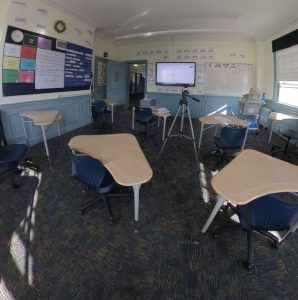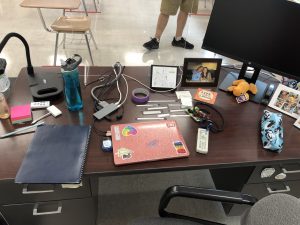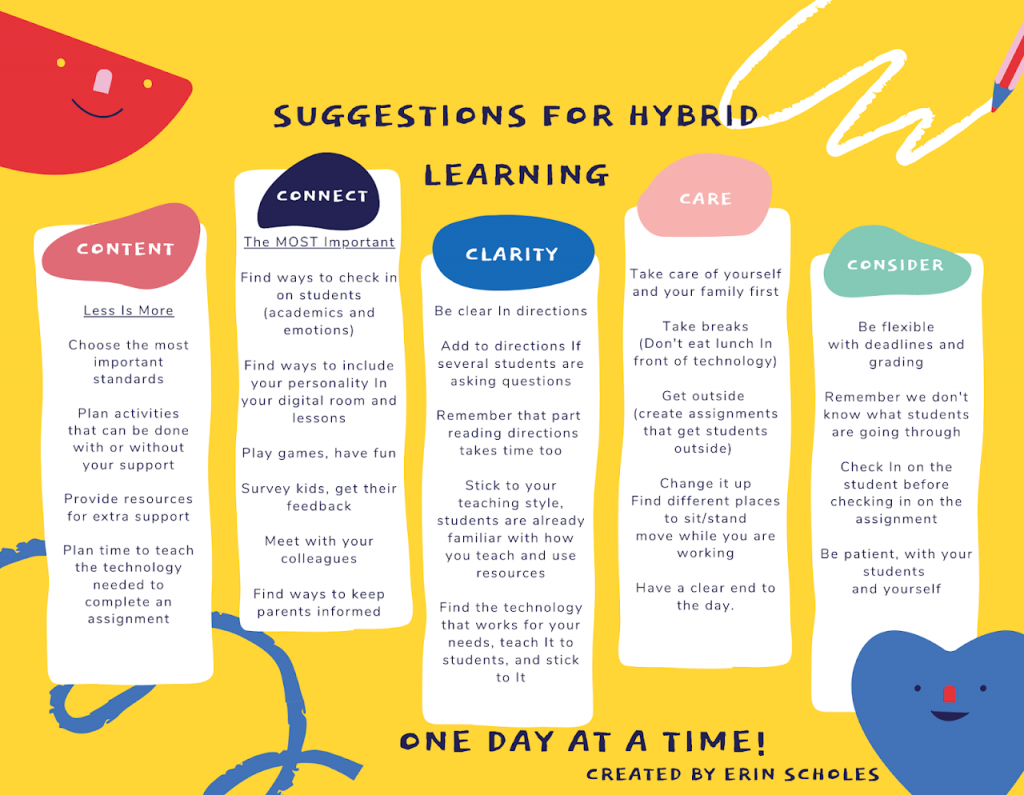Two teachers create an online space, Tech4teachers.info, to help other educators reach their “roomies” and their “Zoomies
This past year’s sudden and seismic shift into virtual learning also thrust educators to step into new roles, including Erin Scholes and JJ Van Ess. The two teachers, one in a public school and the other an independent school, respectively, were already working toward their Masters in Educational Technology at Fairfield University when the pandemic hit. Both stepped up to help their school communities adapt to remote and hybrid learning environments. While their stories and school communities may differ, they both believe that 2021 could lead us into technology integration that helps evolve education in a positive way. Teaching by way of a traditional, in-person method could be a thing of the past, even when the pandemic ends. Erin and JJ sat down to discuss how the pandemic affected their teaching practices – and share their insights for other educators trying to survive and thrive in a hybrid world.
Jumping Headfirst into Remote Learning – and New Roles
“Honestly, the timing of the pandemic was opportune,” says JJ, 7th and 8th grade math teacher and Director of Academic Technology at an all-boys independent school in southern Connecticut.
 “Throughout late February and early March, 2020, we’d all been watching the news of the spread of the COVID-19 and were trying to figure out scenarios going forward.” As spring vacation approached, they shut down the school a few days early and began to prepare. “The timing, at least for us, gave us a window to plan and prep for two weeks and get all of our ducks in a row: a revamped online schedule, online platforms and Learning Management Systems (LMS), and more. Many schools around the country did not have a 2 week break to plan and prepare, they were in a full remote setting by the next week.”
“Throughout late February and early March, 2020, we’d all been watching the news of the spread of the COVID-19 and were trying to figure out scenarios going forward.” As spring vacation approached, they shut down the school a few days early and began to prepare. “The timing, at least for us, gave us a window to plan and prep for two weeks and get all of our ducks in a row: a revamped online schedule, online platforms and Learning Management Systems (LMS), and more. Many schools around the country did not have a 2 week break to plan and prepare, they were in a full remote setting by the next week.”
“The rush to help teachers within my school district be prepared for remote learning didn’t give me time to focus on the full implications of a global pandemic,” reflects Erin, 7th grade math teacher and team leader at a preK-12 public school district in a semi-rural town in northeastern Connecticut. “I am not even joking when I tell you the titles of my two graduate level courses last spring were, ‘Designing for Online Instruction’ and ‘Creating and Curating Digital Content.’ Our professors reminded us on multiple occasions that our launch into remote learning was not what was intended in these courses. But they also realized the situation and supported us through being the technology support within our own school districts.”
 It quickly became clear to district leadership that staff would need training to continue to teach live to students if school buildings closed. Erin was asked to prepare professional development on using learning management systems and video conferencing. “I started my graduate degree with the ultimate goal of becoming an educational technology specialist in a school or district, and there I was with the opportunity to teach our staff new technology. It was definitely a little faster paced than what I would consider ideal, but I was excited to learn new technologies – I had never used Google Meets, and never heard of Zoom. Most importantly, I was happy to provide a little bit of comfort and guidance in what was turning out to be the most uncertain time in everyone’s teaching careers.”
It quickly became clear to district leadership that staff would need training to continue to teach live to students if school buildings closed. Erin was asked to prepare professional development on using learning management systems and video conferencing. “I started my graduate degree with the ultimate goal of becoming an educational technology specialist in a school or district, and there I was with the opportunity to teach our staff new technology. It was definitely a little faster paced than what I would consider ideal, but I was excited to learn new technologies – I had never used Google Meets, and never heard of Zoom. Most importantly, I was happy to provide a little bit of comfort and guidance in what was turning out to be the most uncertain time in everyone’s teaching careers.”
From Remote to Hybrid
JJ’s school was applauded for its dedication to its students during this unprecedented time. Classes were held for all grade levels, work was assigned, assessments administered, and they even held virtual physical education courses. All had high hopes that normalcy would return by the time a new school year came. But that was not the case. Over the summer JJ was tasked with implementing a hybrid infrastructure for his school. This meant purchasing testing and installing new equipment, training staff on how to create a hybrid classroom, synchronously teaching to students both in-person and online, and using online tools to create an equitable learning while incorporating skills such as collaboration, problem solving, critical thinking, and most importantly – resilience.
Erin also used the summer to share her knowledge with colleagues, focusing on how technology can be used to enhance instruction and create interactive learning opportunities for students. In addition, she helped create a professional development website that the district staff could use when they returned in the fall. It was meant to be a “one stop shop” for technology professional development, while also offering “choose your own” options since everyone was coming into the year with varying needs and comfort levels when it came to using technology in the classroom.
Reflect on your Own Teaching Philosophy – Then Integrate Technology
Now, nearly a year after school buildings first closed, JJ can safely say, “hybrid teaching and learning is very doable, and can be fun and engaging… but takes a bit of extra work.” To JJ, teaching Algebra is a pretty simple formula: teach a lesson, do a few examples, assign practice problems and answer questions to ensure student understanding. “Shifting to an online or hybrid classroom, there were many unknowns. Usually, I’d use my personality to get students engaged. I like to jump around the room and engage with my students on a social-emotional level. When you connect with your students, they’re more receptive to learning, even the boring stuff.”
After reflecting on previous practice and her own teaching philosophy, Erin explored the possibilities for organizing her digital/hybrid classroom. Her middle school is operating in a hybrid model with A/B cohorts. Students are in school on their cohort days and learn from home on the other. “For the past eight or so years I have been using Showbie. While much of the district uses Google Classroom, Showbie allows me and the students to write on documents in the system. Knowing that I would be exploring and implementing new technology in other areas, I wanted to stick to a learning management system that I was comfortable with, and that had the features I needed.” Showbie also has voice recording features, and recently added video chat feature, something Erin has yet to use in the classroom.
She also created a Bitmoji classroom and made how-to video tutorials for her staff. There are links to frequently used sites, and “cute little decorations” that match her physical classroom. But its core function is planning. “My Bitmoji classroom has really become my plan book as well. I create one slide show for each week, and often have one or two future weeks open. It helps me organize the plans for each class, and I am able to share it with my co-teacher, student teacher, the math interventionists, and all my students.” Erin also displays this on the screen both in the room and on Zoom, so all students can see the agenda for the day.
Using Tech to Create Equity in a Hybrid Model
To stay safe in a hybrid model, JJ’s school has implemented protocols for students who need to quarantine – leading to even more uncertainty for staff and students. “At points, full grades are forced to stay home, and teachers have to pivot to a full remote classroom at the drop of a hat. With online platforms such as Seesaw and Google Classroom, students on campus or at home can gain access to the same materials. JJ has implemented Google Classroom for both his classes and his school. “Integration with many online platforms is the draw here,” he says. “I’m able to assign work directly from my e-textbook, including extra problems and assigned textbook readings easily.”

While Classroom does have drawbacks, students found the Calendar view of their upcoming assignments for each class helpful. “You have to tweak some settings, and every teacher has their own style.” JJ’s Classroom is organized by Topics, units in his textbook, so that they’re easy to navigate, while keeping important information at the top such as upcoming tests. “Using Google Classroom has allowed me to create equity for both in-person and remote students. With the online textbook, both types of students need a laptop and a notebook to complete the same assignments. It doesn’t matter where they are, they can still get the work done.”
Identify Priorities, Find the Right Tech, Then Tweak
For Erin, it was important to find applications that would allow interactive instruction. PearDeck along with Notes pages in Showbie are her primary tools of delivering instruction. With PearDeck, students login with the classroom code and participate along with a paced lesson. Erin can watch student progress through the teacher dashboard. “The students really like being able to interact with the content. It helps them feel more comfortable participating virtually, since they have had time to prepare their thoughts. I can also monitor all my students and provide direct feedback to them as they work. I am so grateful to have found a way where I can watch students write out their math work in real time.”
For student notes packets, Erin stuck to printing packets for every student and she keeps the class notes electronically in Showbie. “I think it is important that students are able to interact and access their own notes. Math notes have been an evolving process in my class, and it was another area I had to try and adapt.” In addition to being hybrid, Erin’s district also started using a new math curriculum this year. She has had to think carefully about how many “new” things she would be able to tackle in one year and is working hard to keep a healthy balance for herself and her students.
Erin chose ClassKick to distribute and collect student practice. ClassKick allows teachers to see student work in real time and pop into the exact same slide as a student to type, handwrite, or chat to assist them. She can upload previously used content and create new items for students, and also likes the features that allow students to help each other and an automatic grading feature. Erin notes that the free version does take some set-up time with students, and they need to log in the exact same way every time to avoid duplicate accounts in her dashboard. But it has been so successful in her classroom that she even used it to administer a quiz.
While one of JJ’s first obstacles to hybrid was getting over the “anxiety hump,” it was driving student engagement that proved to be the most difficult task of all. “I’ve had great success with platforms that take your current lessons and make them a bit more interactive.” JJ likes to create his lesson plans using Google Slides, and then uses “simple addons like Nearpod and PearDeck that add fun features to any lesson that can take the monotony out of a simple lecture. I can add quick quizzes and contests, mid-lecture, to ensure my students are not only paying attention, but are also understanding the information.”
Assessing Student Learning in a Hybrid Environment
Teaching in an all-boys school, JJ notes that boys learn differently than girls. “They learn through application, through experience, and sometimes even through competition. At the end of a lesson, I like to challenge my students with a competition. Everyone gets out their notebook and opens to a blank piece of paper. Whether your online or in-person, everyone can participate in a fun Kahoot! at the end of a unit or section. My kids race to see who can answer the question not only the fastest, but correctly as well.” Not only have these technology integrations kept students engaged, but have also taken off some of the stress of upcoming assessments.
A big take-away JJ has had this past year is on the role of assessment. “One thing teachers really need to consider this year is the purpose of an assessment. There is no way we can monitor all students in this environment, so we really need to reconsider what our assessments look like, and how they are administered.” For the past few years Erin has been using video projects to assess student understanding of mathematical concepts. “When I first used them three years ago, I was afraid students would have their parents help them and it wouldn’t be a true reflection of their understanding. However, when a student has to explain the how and why of the steps it becomes very clear through their explanation what they understand and what they don’t.” Erin has kept the same outline to her video project but changed up the problems and expectations based on the unit.
Relationships are Still Key – in Any Environment
Erin firmly believes that relationships are the foundation of a successful classroom and was afraid of losing connection with students who were online only. “I paid close attention to what made me feel connected to people in Zoom meetings and found some common things that worked and that I knew I would be able to implement.” When starting any online meeting, there is a greeting period when people are arriving in the meeting. This is a perfect opportunity to greet students by name, to hold the usual entering the classroom “chit-chat” and encourage students to respond by asking them specific questions.
“One thing I found that helped was allowing my two cohorts to interact with each other: my ‘roomies’ and my ‘Zoomies.’ I would turn the camera to face the classroom and put the Zoom window on the front board. It was awesome to watch the kids wave and talk back and forth.” Erin has led advisory lessons, taken time for digital etiquette mini-lessons, and provides feedback to students in response to their emails.
Breakout rooms have also helped build classroom community. When working on a lengthier assignment, Erin puts students together based on their personal preference. “I want this time to be successful for everyone, and honestly I do want them to be able to socialize with their friends, this is a huge part of what is missing from this year.” She is able to move across breakout rooms to provide assistance and monitor conversation. For quicker conversations, what teachers usually refer to as “turn and talk” or “think-pair-share,” assigns slightly larger groups at random, giving students the opportunity to work with different peers. These usually run 2 minutes or less and have very specific directions for conversation.
Starting -or Continuing – your Tech Integration Journey
 As the country sees cases spiking, there is a looming anxiety about entering back into full remote learning. The reality, Erin says, is, “Every teacher has their ‘toolbox’ of teaching strategies. Some teachers take a more traditional approach, a textbook, a lesson, and some conversation. Others dabble in new tools and programs – Kahoot, Bitmoji, GimKit, NearPod, Prezi, FlipGrid, ClassKick, PearDeck and so much more. There is an abundance of online resources and tools available for teachers to integrate into their lessons to increase student engagement and collaboration, but where to even begin?” After reflecting on the past year and the future of education, Erin and JJ collaborated to create Tech4Teachers.info, designed to be any teachers’ one-stop-shop for all things hybrid Learning. Built by teachers for teachers, the site guides educators on what technology to use when and has a page dedicated to “how to tutorials” for each piece of technology referenced. Erin and JJ want the site, to be a place for teachers to find technology to meet their teaching needs and provide the essentials on how to use the technology – now and after the pandemic ends.
As the country sees cases spiking, there is a looming anxiety about entering back into full remote learning. The reality, Erin says, is, “Every teacher has their ‘toolbox’ of teaching strategies. Some teachers take a more traditional approach, a textbook, a lesson, and some conversation. Others dabble in new tools and programs – Kahoot, Bitmoji, GimKit, NearPod, Prezi, FlipGrid, ClassKick, PearDeck and so much more. There is an abundance of online resources and tools available for teachers to integrate into their lessons to increase student engagement and collaboration, but where to even begin?” After reflecting on the past year and the future of education, Erin and JJ collaborated to create Tech4Teachers.info, designed to be any teachers’ one-stop-shop for all things hybrid Learning. Built by teachers for teachers, the site guides educators on what technology to use when and has a page dedicated to “how to tutorials” for each piece of technology referenced. Erin and JJ want the site, to be a place for teachers to find technology to meet their teaching needs and provide the essentials on how to use the technology – now and after the pandemic ends.

I think this is the most useful article I have read so far! This article will really help me during my transition from student to a teacher while in the midst of a pandemic. When I start student teaching and teaching for real, I will definitely be coming back to this article to help me ease through my first year of teaching.